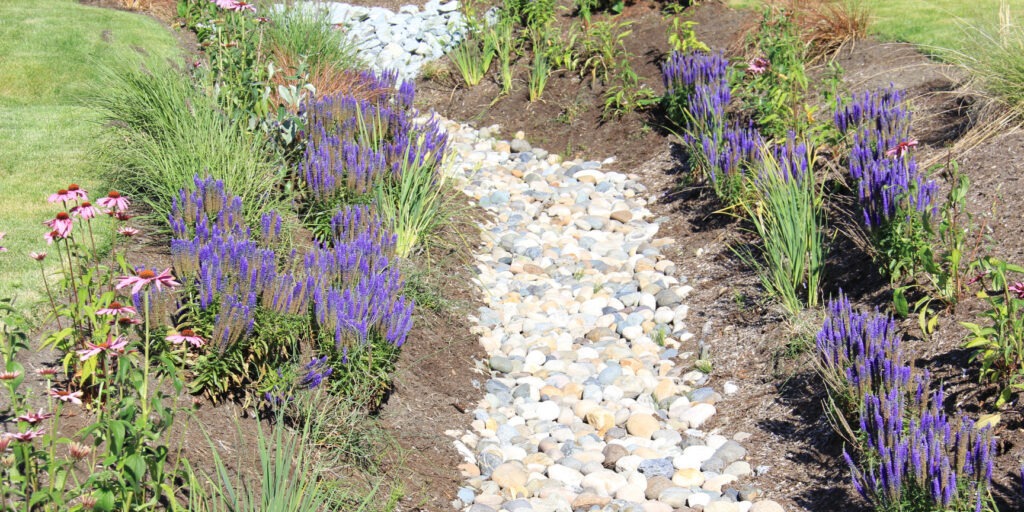We all know that grass needs water to grow, but you can have too much of a good thing. If you’re noticing standing puddles after every rainfall, it could lead to bigger problems. Exploring effective yard drainage solutions is essential to maintain a healthy landscape and prevent water-related issues.
Yard drainage can be accomplished with:
- Soil correction
- French drains
- Aeration
- Dry wells
- Fertilization
Yard Drainage Solutions
Proper yard drainage is essential for maintaining a healthy landscape and preventing various issues. Without adequate drainage, excess water can lead to soil erosion, waterlogged plants, and foundation damage. It also creates breeding grounds for pests and fungi, negatively impacting the aesthetics of your yard.
Effective yard drainage solutions promote healthy plant growth while protecting your home from costly water damage. By managing water flow efficiently, you ensure a thriving outdoor environment that enhances both beauty and functionality.
1. Soil correction
Proper soil correction is one of the key yard drainage solutions, transforming your yard into a more efficient water management system. It reduces the risk of waterlogging and associated drainage problems by modifying the soil to enhance its water absorption capabilities.
By incorporating organic matter such as compost, the soil structure is significantly improved, increasing its ability to absorb and retain water. This creates more pore spaces in the soil and allows water to percolate more easily through the ground rather than pooling on the surface.
Additionally, soil correction can involve adjusting pH levels and nutrient content. This aids in drainage by promoting healthier plant growth.
2. French drains
This type of irrigation system consists of a perforated pipe surrounded by gravel that is installed in a sloped trench. As water accumulates in the soil, it enters the pipe through the perforations and is redirected away from the problem area.
French drains excel at catching surface and subsurface water, making them ideal for addressing issues like:
- Soggy lawns
- Foundation seepage
- Persistent puddles
They can be customized to fit various landscape designs and are particularly useful in yards with clay soil or areas prone to heavy rainfall.
3. Aeration
Aeration is one of the most effective yard drainage solutions available to homeowners. This process involves creating small holes in the soil to help reduce compaction. It also allows water, air, and nutrients to penetrate deeper into the ground.
Aeration improves soil structure by improving water absorption, preventing surface pooling, and reducing runoff. This is particularly beneficial in areas with heavy foot traffic or frequent rainfall, where soil tends to become compacted over time.
Regular aeration not only enhances drainage but also promotes healthier root growth and overall lawn vitality. As a result, your yard becomes more resilient to water-related issues.
4. Dry wells
Dry wells are an effective yard drainage solution that helps manage excess water by providing a designated underground storage area. These structures consist of a large hole filled with gravel or a perforated container that collects and slowly disperses water into the surrounding soil.
When integrated into a comprehensive yard drainage system, dry wells can significantly reduce surface water runoff and prevent flooding in low-lying areas. They are particularly useful for handling water from downspouts, sump pumps, or other drainage pipes.
By allowing water to gradually seep into the ground, dry wells help maintain the natural water cycle and prevent erosion. This makes them an environmentally friendly option for improving yard drainage, especially in areas with heavy rainfall or poor soil permeability.
5. Fertilization
While fertilization is not typically considered one of the primary yard drainage solutions, it can indirectly contribute to improved water management. For optimal results, it should be combined with other yard drainage solutions such as soil correction and aeration.
These methods collectively contribute to better drainage by working together to:
- Improve soil structure
- Enhance water absorption
- Promote overall yard health
Proper fertilization also promotes healthy grass and plant growth that enhances soil structure through robust root systems. These stronger roots create channels in the soil, allowing for better water infiltration and reducing surface runoff. Additionally, healthy plants absorb more water, helping to mitigate excess moisture in the yard.
Choose Grover Turf Care for Improved Yard Drainage in Knoxville
At Grover Turf Care, our comprehensive approach to lawn health can help improve your property’s yard drainage. Our services include soil corrections and aeration to significantly improve your lawn’s soil structure and water absorption. By focusing on creating deeply-rooted, flourishing lawns, Grover helps establish a natural defense against water pooling.
Our expertise in East Tennessee soil and weather conditions allows us to tailor treatments that promote lawn resilience, aiding in managing excess water. Additionally, our pet-safe herbicides and nutrient-rich soil amendments enhance overall soil health to help improve yard drainage.

Proper yard drainage is essential for a healthy landscape, preventing issues like soil erosion, waterlogged plants, and foundation damage. Effective solutions include soil correction, French drains, aeration, dry wells, and fertilization. Grover Turf Care offers tailored services to enhance soil structure and water absorption, promoting a thriving outdoor environment in Knoxville.




